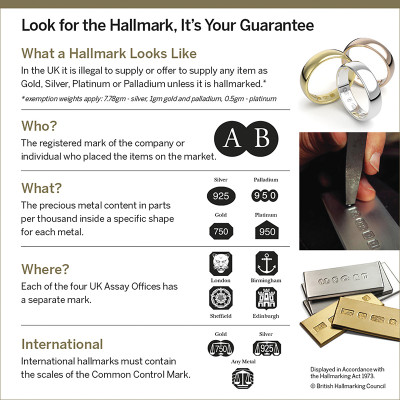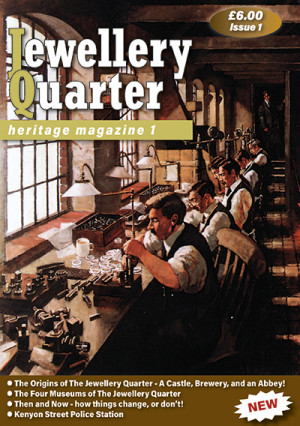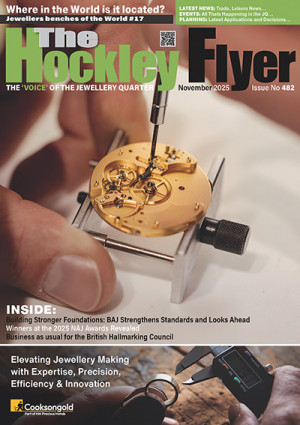 Happy Birthday to the Hallmarking Act which was given royal assent on 25th July 1973 and came into force fully on 1st January 1975. 200 years earlier in July 1773, the newly created Sheffield and Birmingham Assay Offices each held meetings to elect their first Wardens. So much has changed to impact hallmarking since both of those dates, but still the rigorous statutory UK regime remains vitally important, protecting the trade and the consumer.
Happy Birthday to the Hallmarking Act which was given royal assent on 25th July 1973 and came into force fully on 1st January 1975. 200 years earlier in July 1773, the newly created Sheffield and Birmingham Assay Offices each held meetings to elect their first Wardens. So much has changed to impact hallmarking since both of those dates, but still the rigorous statutory UK regime remains vitally important, protecting the trade and the consumer.
The 1973 Act had a difficult and prolonged birth as its creators worked to standardise over 600 years of legislation, eradicate archaic laws and create a simpler, more intelligible framework. It was first recognised that change and simplification were needed back in 1878 but it was 1955 before a committee finally began developing the current Act.
The Hallmarking Act 1973 specifically repealed thirty-five pieces of archaic and complex legislation, the oldest dating back to 1696. Several key changes were made to the regime which was by now 650 years old.
Date letters were standardised across all four Assay Offices making them far easier to interpret. Platinum was added and millesimal marks indicating the precious parts of metal per thousand, already in use for silver, were introduced for all (at the time) three precious metals. For gold hallmarks the use of 9ct, 18ct etc beside a crown was therefore replaced by 375, 750 etc.
Each Assay mark was clearly defined. Sheffield’s Crown assay mark which it had struck on silver since 1773 was replaced with the Rose, which had been introduced in 1904 when Sheffield began marking gold. The 1973 Act established the Rose alongside London’s Leopard’s Head, Edinburgh’s Castle and Birmingham’s Anchor for all items made in the UK.
So far so simple but items made outside the UK were still differentiated. Each Assay Office continued to apply a different assay mark assigned for imported items and only a millesimal fineness mark could be applied, without the accompanying traditional crown or sterling lion.
The 1973 Act also created the British Hallmarking Council to oversee the Assay Offices and ensure adequate provision for hallmarking in the UK. The body is entirely funded by the four Assay Offices whose representatives attend regular meetings alongside 19 members appointed by the Secretary of State and the Assay Offices as stipulated by the Act.
So, it is worth celebrating that nearly 100 years after a need for change was identified the new legislation came into force.
However, the talented and progressive jewellery industry never stands still. Since 1975 the Act has been amended numerous times in order to remain appropriate and relevant to an innovative and ever-changing industry now operating in a global market.
The most significant legislative changes were in 1999 in order to protect our uniquely independent, statutory system from EU Harmonisation within the Single Market. Differentiation according to source was abolished and the same Assay Office mark applied whatever the country of origin. To ensure a UK hallmark is intelligible to an international audience traditional marks became optional extras, as did date letters. In response to economic trends Mixed Metal rules were relaxed in 2007, to allow affordable items combining high priced precious metals with lower priced precious or base materials to be hallmarked and therefore described correctly. Hallmarking for Palladium was added in 2009, the fourth precious metal to require hallmarking.
In the meantime, the jewellery industry and its consumer market have progressed through radical changes. The four UK Assay Offices have a statutory duty to test and mark any item that falls within the legislation and their processes have had to keep up with new customer demands. X Ray fluorescence testing is quicker, cleaner, and less damaging than traditional fire assay or titration analysis. It is the only acceptable way to assay finished, polished, items and to efficiently process the hundreds of small orders which have replaced the bulk batches of the early 2000’s. Laser marking has been developed for lightweight, hollow items which cannot tolerate the impact of a punch. Lean manufacturing and high metal prices demand a shorter critical path and “One hour” or “Same Day” services are in demand. Each of the Offices has invested heavily in training and technology to ensure their processes are fit for purpose.
With so much change happening in the background it is easy to overlook the original objective of hallmarking.
All the time, effort and investment over the past 50 years is intended to protect the trade from unfair competition and the consumer from being cheated. If the consumer is not aware of the benefits of a hallmark and therefore doesn’t check for it when buying it is all for nothing. Consumer education is vital. The BHC and the NAJ are strongly encouraging all members of the trade and particularly those who have interface of any sort with consumers to celebrate the hallmark within their business and with their customers as it reaches 50 years in its current format. The HALO Award is open to entries from all jewellers until mid-September; an impressive reward for those who create the most effective initiative to promote the hallmark. More info can be found at www.NAJ.co.uk/halo
More information:
🌐 www.britishhallmarkingcouncil.gov.uk





